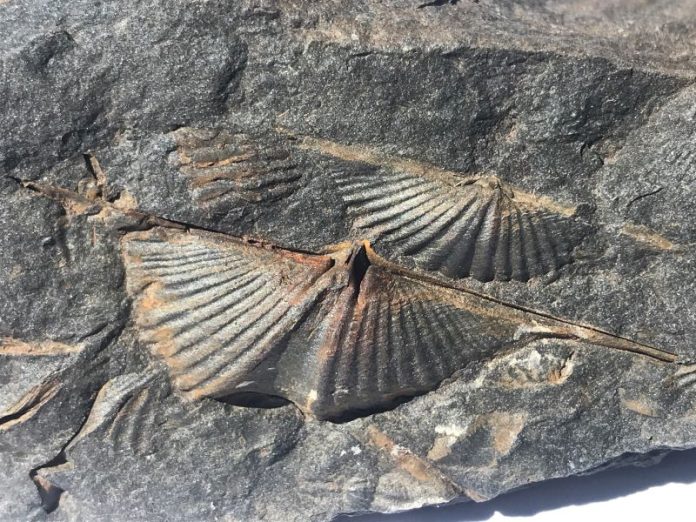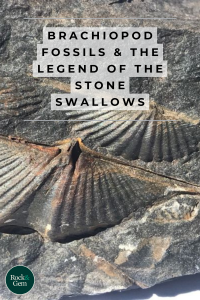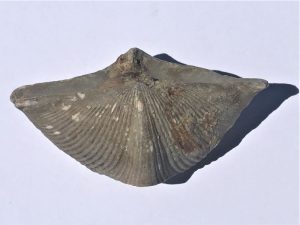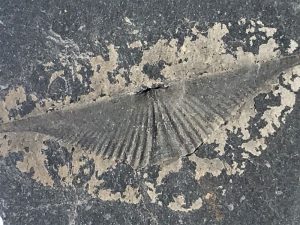
A perfect brachiopod fossil looks for all the world like the spread wings of butterflies and swallows. Fossil collectors each March 19 may be reminded of these fossils on St. Joseph’s Day, the annual miracle of the Swallows of Capistrano takes place at Mission San Juan Capistrano in California, to celebrate the return of these streamlined and swift-flying birds. To the ancient Chinese, this spiriferid brachiopod fossil was indeed a “stone swallow.” Here’s the legend beyond that of San Juan Capistrano…

The Legend of Shih Yen
Toward the end of the fifth century A.D., a Chinese scholar named Li Tao-Shan wrote that in the mountain called Shi-Yen Shan (Stone Swallow Mountain), “there are a sort of stone oysters which look like swallows… During thunderstorms those ‘stone-swallows’ fly about as if they were real swallows.” Such stone swallows (shih yen) with elegant outstretched wings were so valued for their beauty that they were collected from the rocks as gifts for the Chinese emperor.
Swallows, Butterflies — Or Fossils?
Neither swallow nor butterfly, these winged stones were what we today call brachiopods. Although superficially similar in appearance to bivalves (which include such mollusks such as clams, oysters and scallops), brachiopods belong to a fundamentally different taxonomic group. Rather than bivalves or mollusks, they are lophophorates.
Brachiopods are a truly ancient group of critters. But they still exist in the oceans of today, even if confined to restricted deep-sea ecological niches. In other words, you won’t commonly find them washed ashore when beachcombing along today’s seaside sands.
But in days past, brachiopods were far more common in marine environments. In fact, they form one of the most common fossils you’ll find in Paleozoic sediments ranging from 540 to 250 million years ago. If you were to have walked the seaside during those days, you would have found brachiopods in abundance. On a personal note… while growing up in Illinois, brachiopods were one of the most common fossils I found on fossilcollecting field trips in sediments left by ancient seashores, particularly from the Ordovician Period.

Brachiopod Fossil: Other Cultures
While today we see brachiopods as fossil relics from times past and the Chinese have their legend of Stone Swallow Mountain, other cultures have interpreted these fossils in other ways. For instance, within the Devon region of the United Kingdom, such winged brachiopods are called “Delbole butterflies” after the quarry where they were first commonly found.
Neolithic engravings at grave sites in the Meath region show fan shapes reminiscent of spiriferid brachiopods. While some interpret these to be sundials, others see totally realistic depictions of brachiopods.
In the Swabian Alps of southern Germany, these brachiopods have been called täubli, or “little doves.”
Whether called butterflies, little doves, or swallows, such wonderfully distinctive fossils etched in ancient stone have attracted human attention for time untold.

Adobe Stock / ASTA Concept
A Personal Find
When I was a young child, I was collecting fossils with my father along a road cut off the beaten path in the Appalachian mountains of Virginia. Primarily, we were seeking trilobites and brachiopods. Suddenly, a kind old gentleman pulled over in a beat-up antique Ford truck spouting exhaust, much like the truck my grandfather drove on his farm. He asked what we were seeking. When we said, “fossils,” he pointed up the road and said we could find petrified butterflies another three miles on. With that, he patted the side of his truck door and drove off.
Butterflies? In 400-million-year-old rocks from the Devonian Period? That was long before butterflies appeared in the fossil record 56 million years ago! Still, we checked it out. Instead of butterflies, we discovered an abundance of “spiriferid” or winged brachiopods. Many of those we collected that day remain in my collection some 60 years later. Truly beautiful!
Do You, Too, Have a Stone Swallow?
Check out your own collection. Do you, too, have one of these legendary fossil “swallows?” If so, treasure it. This interesting brachiopod fossil has been considered truly unique across time and culture.
This story about the brachiopod fossil and stone swallows appeared in Rock & Gem magazine. Click here to subscribe. Story by Jim Brace-Thompson.














